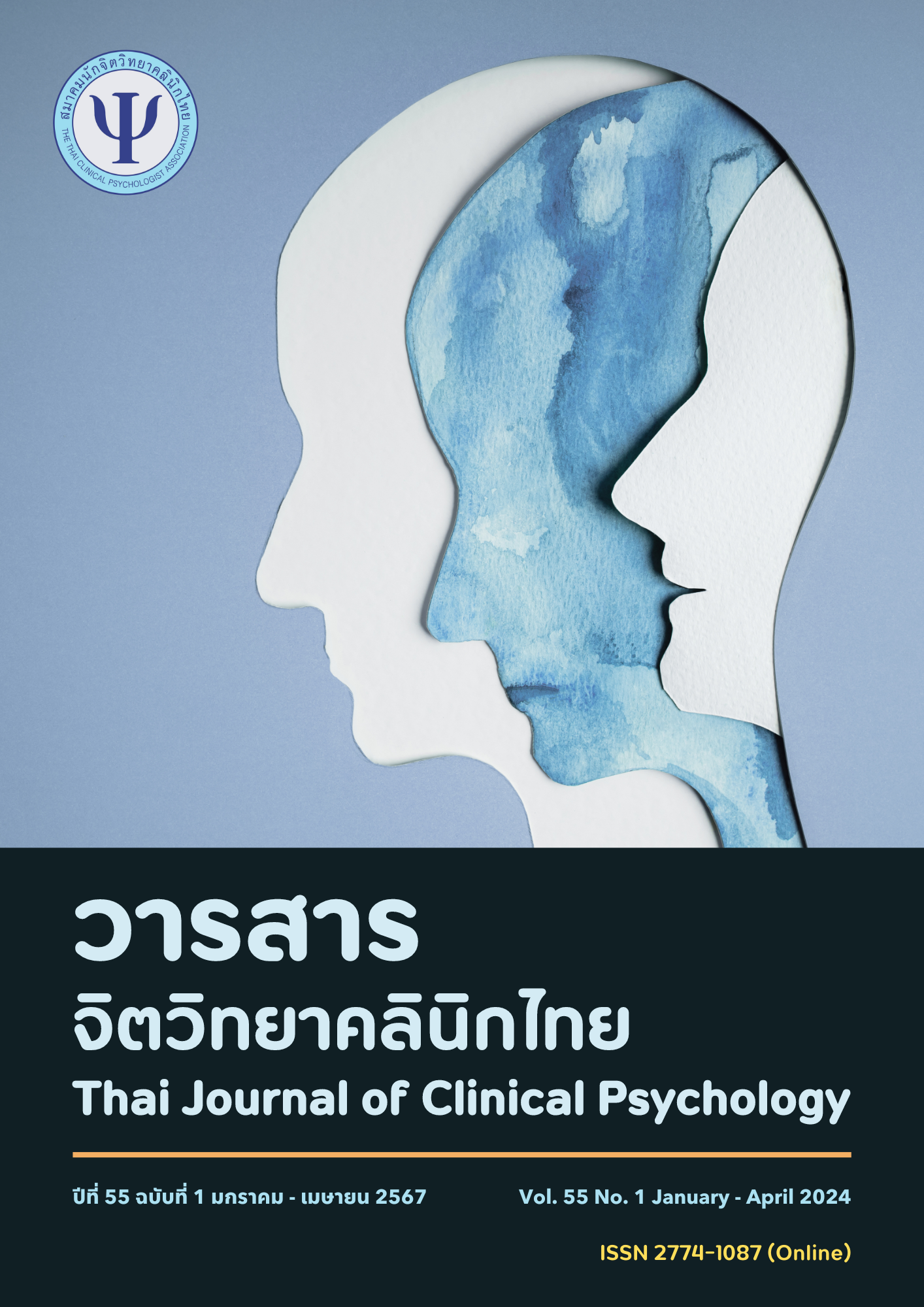ปัจจัยที่มีผลต่อความสามารถของผู้ดูแลในการดูแลเด็กและวัยรุ่นสมาธิสั้น ณ ห้องตรวจผู้ป่วยนอกจิตเวชเด็กและวัยรุ่น โรงพยาบาลนครปฐม
Main Article Content
บทคัดย่อ
วัตถุประสงค์ เพื่อศึกษาความสามารถของผู้ดูแลในการดูแลเด็กและวัยรุ่นสมาธิสั้น ณ ห้องตรวจผู้ป่วยนอกจิตเวชเด็กและวัยรุ่น โรงพยาบาลนครปฐม วัสดุและวิธีการ เป็นการวิจัยเชิงสำรวจภาคตัดขวาง กลุ่มตัวอย่างคือผู้ดูแลเด็กและวัยรุ่นสมาธิสั้นที่มารับบริการ ณ ห้องตรวจผู้ป่วยนอกจิตเวชเด็กและวัยรุ่น โรงพยาบาลนครปฐม จำนวน 250 คน เครื่องมือที่ใช้คือ แบบสอบถามข้อมูลทั่วไป และแบบวัดความสามารถในการดูแลเด็กและวัยรุ่นสมาธิสั้น สถิติที่ใช้ ได้แก่ ความถี่ ร้อยละ ค่าเฉลี่ย ค่าเบี่ยงเบนมาตรฐาน ไคสแควร์ การทดสอบของฟิชเช่อ และการวิเคราะห์ถดถอยลอจิสติก ผลการศึกษา พบว่า ความสามารถในการดูแลเด็กและวัยรุ่นสมาธิสั้นภาพรวมอยู่ในระดับปานกลางค่อนข้างสูง (M = 279.78, S.D.=36.540 โดยตัวแปรพยากรณ์ทางด้านบวกที่มีผลต่อความสามารถในการดูแล คือ ผู้ดูแลเพศหญิง การมีรายได้ 20,001 บาทขึ้นไป การมีผู้ร่วมดูแล และผลการเรียนของเด็ก 3.00 ขึ้นไป ส่วนตัวแปรพยากรณ์ทางด้านลบคือ การมีโรคประจำตัวของผู้ดูแล และการมีโรคทางจิตเวชของผู้ดูแล โดยตัวพยากรณ์ท้ังหมดมีค่าอิทธิพลต่อความสามารถของผู้ดูแลเด็กและวัยรุ่นสมาธิสั้นร่วมกัน ร้อยละ 53.00 สรุป ผู้ดูแลที่เป็นเพศหญิง การมีรายได้ 20,001 บาทขึ้นไป การมีผู้ร่วมดูแล และผลการเรียนของเด็ก 3.00 ขึ้นไป คาดว่าจะมีผลต่อการเพิ่มความสามารถในการดูแล ส่วนการมีโรคประจำตัวและการมีโรคทางจิตเวชของผู้ดูแลอาจทำให้ความสามารถของผู้ดูแลลดลง ดังนั้นผู้ดูแลที่มีโรคประจำตัวและโรคทางจิตเวช จึงควรได้รับคำแนะนำจากผู้เชี่ยวชาญในการดูแลเด็กและวัยรุ่นสมาธิสั้นอย่างเหมาะสมต่อไป
Article Details

อนุญาตภายใต้เงื่อนไข Creative Commons Attribution-NonCommercial-NoDerivatives 4.0 International License.
เรื่องที่ลงตีพิมพ์ในวารสารจิตวิทยาคลินิกแล้วถือเป็นลิขสิทธิ์การเผยแพร่โดยวารสารจิตวิทยาคลินิกแต่เพียงผู้เดียว การตีพิมพ์หรือเผยแพร่ซ้ำในที่อื่นต้องได้รับอนุญาตจากกองบรรณาธิการวารสารฯ
เอกสารอ้างอิง
Adeosun, I. I., Ogun, O., Adegbohun, A., Ijarogbe, G., & Fatiregun, O. (2017). The burden on caregivers of children with attention-deficit hyperactivity disorder in Lagos Nigeria: prevalence and correlates. Journal of Education, Society and Behavioural Science, 22(1), 1-7.
ADHD Western Australia. (n.d). What is ADHD: Parents and caregivers. Retrieved on June 2, 2023, from https://www.adhdwa.org/what-isadhd/parents-and-caregivers/
Alnakhli, Z. J., Almutari, S., & Al-Dubai, S. A. R. (2020). Assessment of burden on caregivers of children with attention deficit/hyperactivity disorder in Al-Madinah, Saudi Arabia. International Journal of Medical Research &
Health Sciences, 9(11), 10-17.
American Psychiatric Association. (2013). Diagnostic and statistical manual of mental disorders (5th ed). American Psychiatric Association.
Barkley, R. A. (2022). Fact sheet: Attention deficit hyperactivity disorder (ADHD) topics. Guilford Publications.
Carpena, M. X., Hutz, M. H., Salatino-Oliveira, A., Polanczyk, G. V., Zeni, C., Schmitz, Chazan, R., Genro, J. P., Rohde, L. A., & Tovo-Rodrigues, L. (2019). CLOCK polymorphisms in attentiondeficit/hyperactivity disorder (ADHD): Further
evidence linking sleep circadian disturbances and ADHD. Genes, 10(2), 88.
Cortina, J. M. (1993). What is coefficient alpha? An examination of theory and applications. Journal of Applied Psychology, 78(1), 98.
Davis, C. C., Claudius, M., Palinkas, L. A., Wong, J. B., & Leslie, L. K. (2012). Putting families in the center: Family perspectives on decision making and ADHD and implications for ADHD care. J. Atten. Disord, 16, 675-684.
de Freitas de Sousa, A., Coimbra, I. M., Castanho, J. M., Polanczyk, G. V., & Rohde, L. A. (2020). Attention deficit hyperactivity disorder. In J. M. Rey, & A. Martin, (eds), J.M. Rey’s IACAPAP eTextbook of Child and Adolescent Mental
Health. International Association for Child and Adolescent Psychiatry and Allied Professions.
Drechsler, R., Brem, S., Brandeis, D., Grünblatt, E., Berger, G., & Walitza, S. (2020). ADHD: Current concepts and treatments in children and adolescents. Neuropediatrics, 51(5), 315-335.
Fromm, E. (1995). The art of loving. Thorsons. Hess, R. D. (1981). Approaches to the measurement
and interpretation of parent-child interaction'in R. W. Henderson, (Ed.), Parent-child interaction, theory, research, and prospects (pp. 207-230). Academic Press Inc.
Magliano, L., Marasco, C., Fiorillo, A., Malangone, C., Guarneri, M., & Maj, M. (2002). The impact of professional and social network support on the burden of families of patients with schizophrenia in Italy. Acta Psychiatrica
Scandinavia, 106(4), 291-298.
Maneerat, S., Issaramalai, S., & Petcharat, B. (2007, August 1-3). Caregivers' caring ability of children and adolescents with attention deficithyperactivity disorder [Paper presentation]. 6th Annual International Mental Health Conference
"Mental Health in the City", Bangkok, Thailand. (In Thai).
Marrón, E. M., Redolar-Ripol, D., Boixadós, M., Nieto, R., Guillamón, N., Hernández, E., & Gómez, B. (2013). Burden on caregivers of children with cerebral palsy: Predictors and related factors*. Univ. Psychol, 12(3), 767-777.
Medical Records of Department of Psychiatric and Drugs. (2023). Information about ADHD patients. Child and Adolescent Psychiatric Outpatient Department, Nakhon Pathom Hospital. (In Thai).
Ngamkum, D. (2011). Relationships between family factors and behavioral problems in children with attention-deficit hyperactivity disorder, eastern region. (Unpublished master’s thesis), Chulalongkorn University. (In Thai).
Nielsen, T. C., Nassar, N., Shand, A. W, Jones, H., Guastella, A. J., Dale, R. C., & Lain, S. J. (2021). Association of maternal autoimmune disease with attention-deficit/hyperactivity disorder in children. JAMA Pediatrics, 175(3), e205487-
e205487.
Orem, D. E., Taylor, S. G., & Renpenning, K. M. (2001). Nursing: Concepts of practice (6th ed.). Mosby.
Pornnoppadol, C. (2022). Attention deficithyperactivity disorder: Can be treating. Corporate Communication Unit, General Administration Division, Mahidol University. (In Thai).
Power, T. J., Soffer, S. L., Cassano, M. C., Tresco, K. E., & Mautone, J. A. (2011). Integrating pharmacological and psychosocial interventions for attention deficit hyperactivity disorder: An evidence-based, participatory approach. In S. W. Evans & B. Hoza (Eds.), Treating attention deficit hyperactivity disorder: Assessment and intervention in developmental context (pp. 1-19). Civic Research Institute.
Ryan, S. (2023). How caregivers can promote school success for children with ADHD. Choc.org.
Sangkaew, T., Nukaew, O. & Suttharangsee, W. (2017). The effects of an aggressive behavior management program on bahaviors of children suffering from attention deficit hyperactivity disorder (ADHD). The Southern
College Network Journal of Nursing and Public Health, 4(Special), 214-229. (in Thai).
Srisa-ard, B. (2017). Basic Research (10th ed.). Suviriyasarn. (in Thai).
Thainaphriao, K. (2021). Factors predicting caring behavior of caregivers for medication adherence of school-age children with attention deficit hyperactivity disorder. (Unpublished master’s thesis), Prince of Songkla University. (In Thai).
The Royal College of Pediatricians of Thailand. (2017). Guidelines for parents to disseminate knowledge about childcare and development, school age children 6-12 years. The Royal College of Pediatricians of Thailand, Pediatric
Society of Thailand. (In Thai).
Udomchotphruet, P. (2023). Predicting depression in caregivers of children and adolescents with attention-deficit hyperactivity disorder (ADHD) at child and adolescent psychiatric clinic, Nakhonpathom Hospital. Region 4-5 Medical
Journal, 42(1), 51-62. (In Thai).
Yeh, M., Aarons, G. A., Ho, J., Leslie, L. K, McCabe, K., Tsai, K., & Hough, R. (2014). Caregiver etiological explanations and longitudinal medication use for youths with attention deficit hyperactivity disorder. Adm. Policy Ment. Health, 41, 401-409.
Zhao, X., Hayes, T., Timmons, A. C., Wu, W., & Frazier, S. L. (2023). Unpacking inequities in ADHD diagnosis: Examining individual‑level race/ethnicity and state‑level online information‑seeking patterns. Administration and Policy in Mental Health and Mental Health Services Research, 50, 576-590.


